Intel Core i7 3960X (Sandy Bridge E) Review: Keeping the High End Alive
by Anand Lal Shimpi on November 14, 2011 3:01 AM EST- Posted in
- CPUs
- Intel
- Core i7
- Sandy Bridge
- Sandy Bridge E
No Integrated Graphics, No Quick Sync
All of this growth in die area comes at the expense of one of Sandy Bridge's greatest assets: its integrated graphics core. SNB-E features no on-die GPU, and as a result it does not feature Quick Sync either. Remember that Quick Sync leverages the GPU's shader array to accelerate some of the transcode pipe, without its presence on SNB-E there's no Quick Sync.
Given the target market for SNB-E's die donor (Xeon servers), further increasing the die area by including an on-die GPU doesn't seem to make sense. Unfortunately desktop users suffer as you lose a very efficient way to transcode videos. Intel argues that you do have more cores to chew through frames with, but the fact remains that Quick Sync frees up your cores to do other things while SNB-E requires that they're all tied up in (quickly) transcoding video. If you don't run any Quick Sync enabled transcoding applications, you won't miss the feature on SNB-E. If you do however, this will be a tradeoff you'll have to come to terms with.
Tons of PCIe and Memory Bandwidth
Occupying the die area where the GPU would normally be is SNB-E's new memory controller. While its predecessor featured a fairly standard dual-channel DDR3 memory controller, SNB-E features four 64-bit DDR3 memory channels. With a single DDR3 DIMM per channel Intel officially supports speeds of up to DDR3-1600, with two DIMMs per channel the max official speed drops to 1333MHz.
With a quad-channel memory controller you'll have to install DIMMs four at a time to take full advantage of the bandwidth. In response, memory vendors are selling 4 and 8 DIMM kits specifically for SNB-E systems. Most high-end X79 motherboards feature 8 DIMM slots (2 per channel). Just as with previous architectures, installing fewer DIMMs is possible, it simply reduces the peak available memory bandwidth.
Intel increased bandwidth on the other side of the chip as well. A single SNB-E CPU features 40 PCIe lanes that are compliant with rev 3.0 of the PCI Express Base Specification (aka PCIe 3.0). With no PCIe 3.0 GPUs available (yet) to test and validate the interface, Intel lists PCIe 3.0 support in the chip's datasheet but is publicly guaranteeing PCIe 2.0 speeds. Intel does add that some PCIe devices may be able to operate at Gen 3 speeds, but we'll have to wait and see once those devices hit the market.
The PCIe lanes off the CPU are quite configurable as you can see from the diagram above. Users running dual-GPU setups can enjoy the fact that both GPUs will have a full x16 interface to SNB-E (vs x8 in SNB). If you're looking for this to deliver a tangible performance increase, you'll be disappointed:
| Multi GPU Scaling - Radeon HD 5870 CF | |||||
| Max Quality, 4X AA/16X AF | Metro 2033 (19x12) | Crysis: Warhead (19x12) | Crysis: Warhead (25x16) | ||
| Intel Core i7 3960X (2 x16) | 1.87x | 1.80x | 1.90x | ||
| Intel Core i7 2600K (2 x8) | 1.94x | 1.80x | 1.88x | ||
Modern GPUs don't lose much performance in games, even at high quality settings, when going from a x16 to a x8 slot.
I tested PCIe performance with an OCZ Z-Drive R4 PCIe SSD to ensure nothing was lost in the move to the new architecture. Compared to X58, I saw no real deltas in transfers to/from the Z-Drive R4:
| PCI Express Performance - OCZ Z-Drive R4, Large Block Sequential Speed - ATTO | ||||
| Intel X58 | Intel X79 | |||
| Read | 2.62 GB/s | 2.66 GB/s | ||
| Write | 2.49 GB/s | 2.50 GB/s | ||
The Letdown: No SAS, No Native USB 3.0
Intel's current RST (Rapid Story Technology) drivers don't support X79, however Intel's RSTe (for enterprise) 3.0 will support the platform once available. We got our hands on an engineering build of the software, which identifies the X79's SATA controller as an Intel C600:
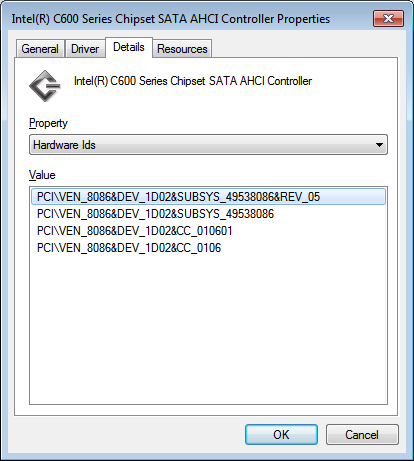
Intel's enterprise chipsets use the Cxxx nomenclature, so this label makes sense. A quick look at Intel's RSTe readme tells us a little more about Intel's C600 controller:
SCU Controllers:
- Intel(R) C600 series chipset SAS RAID (SATA mode)
Controller
- Intel C600 series chipset SAS RAID ControllerSATA RAID Controllers:
- Intel(R) C600 series chipset SATA RAID ControllerSATA AHCI Controllers:
- Intel(R) C600 series chipset SATA AHCI Controller
As was originally rumored, X79 was supposed to support both SATA and SAS. Issues with the implementation of the latter forced Intel to kill SAS support and go with the same 4+2 3Gbps/6Gbps SATA implementation 6-series chipset users get. I would've at least liked to have had more 6Gbps SATA ports. It's quite disappointing to see Intel's flagship chipset lacking feature parity with AMD's year-old 8-series chipsets.
I ran a sanity test on Intel's X79 against some of our H67 data for SATA performance with a Crucial m4 SSD. It looks like 6Gbps SATA performance is identical to the mainstream Sandy Bridge platform:
| 6Gbps SATA Performance - Crucial m4 256GB (FW0009) | ||||||
| 4KB Random Write (8GB LBA, QD32) | 4KB Random Read (100% LBA, QD3) | 128KB Sequential Write | 128KB Sequential Read | |||
| Intel X79 | 231.4 MB/s | 57.6 MB/s | 273.3 MB/s | 381.7 MB/s | ||
| Intel Z68 | 234.0 MB/s | 59.0 MB/s | 269.7 MB/s | 372.1 MB/s | ||
Intel still hasn't delivered an integrated USB 3.0 controller in X79. Motherboard manufacturers will continue to use 3rd party solutions to enable USB 3.0 support.


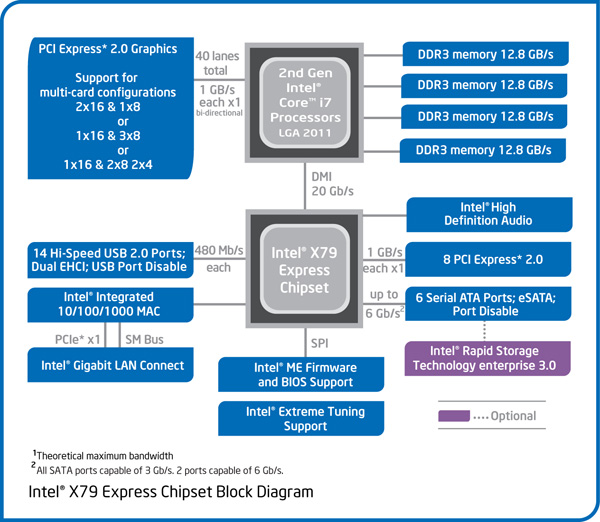
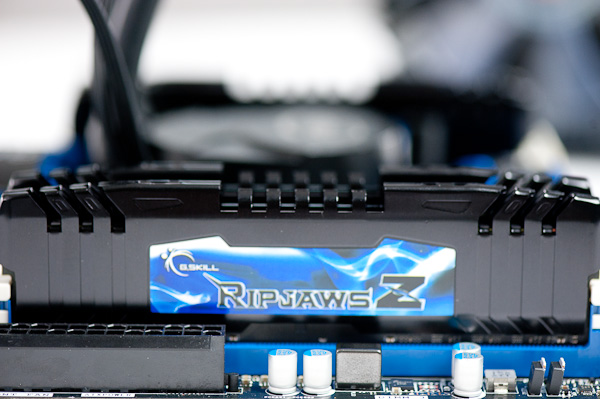
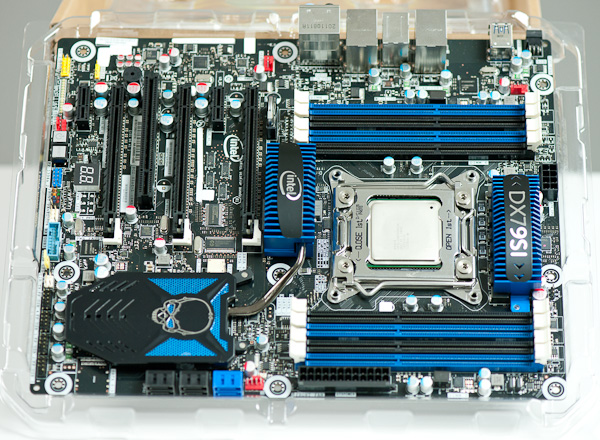
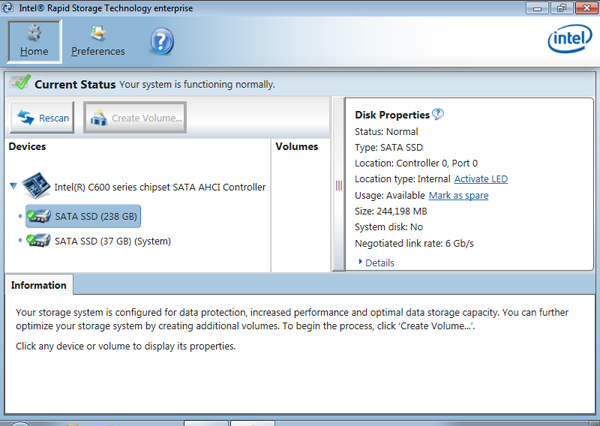








163 Comments
View All Comments
yankeeDDL - Monday, November 14, 2011 - link
I'm with you xpclient.I will never understand Microsoft's fanboys. Why do they expect the OS to make such huge impact on the benchmarks?
It's like for motherboards: you can differentiate for ease of use, stability, features, supported hardware ... but the benchmarks, will substantially be the same.
XP trails Windows7 on multi core because it was never designed to support so many cores, and MS has no interest in updating it.
Per Hansson - Monday, November 14, 2011 - link
Hi, what resolution and in game graphical settings where used for the World of Warcraft gaming test?It always amazes me how well that game scales with super high-end CPU's, but if it's at just a silly low resolution it does not really matter, so, which is it? (This isn't mentioned in "bench" either....)
Per Hansson - Monday, November 21, 2011 - link
Here is Anand's reply to this question incase anyone cares ;)---
1680 x 1050, 4X AA, all detail settings maxed (except for weather) :)
Take care,
Anand
Mightytonka - Monday, November 14, 2011 - link
Typo on the second page. Should read RST (Rapid Storage Technology), right?Ocire - Monday, November 14, 2011 - link
Nice review! :-)If you want to test PCIe bandwidth, you could use the bandwidth-test that comes with the CUDA SDK. It's easy to setup, and you can also test configurations with multiple GPUs. You should get quite reliable results for pure PCIe Gen.2 performance with that.
It would be really interesting to get some performance numbers for PCIe as that is the bottleneck in quite a few GPU-computing scenarios.
Cheers!
LancerVI - Monday, November 14, 2011 - link
Sounds like a great, enthusiast proc, married to a mainstream chipset at enthusiast prices.That means 'no joy' for me.
I guess I'll be hanging on to my little i7 920 that could for a bit longer. Going on 4 years now. That's unheard of for me!!!
hechacker1 - Monday, November 14, 2011 - link
I'm also going to hang onto the i7 920. Overclocked the x58 platform can still compete with the best of of Sandy Bridge for almost any workload. Sure we're missing some IPC and power enhancements, but nothing worth spending serious cash on.What I'm looking at now is the Gulftown prices. I'm hoping they come down from the $1000 Extreme part, and perhaps we get an affordable 6-core chip for the X58 platform.
I'd be happy to stick with Gulftown until we see affordable 8 core parts, or major IPC improvements.
Makaveli - Monday, November 14, 2011 - link
the 980 non X version is already going for $550This is your next upgrade, as is mine i'm also on a 920.
I doubt that price will drop any lower.
hechacker1 - Monday, November 14, 2011 - link
Yeah I'm going to be watching the prices closely for a while.At $550 for the lowest end Gulftown on newegg, it's still not affordable for me.
It's still cheaper than the intro prices of Sandy Bridge-E including a new motherboard though.
I'll have to watch forums closely for people wanting to sell their chips, I imagine you can snag one used for a good deal.
davideden - Monday, November 14, 2011 - link
I currently have a Core i7 2600K LGA 1155 processor. I am assuming that I won't be able to use this with the new LGA 2011 socket on the new Sandy Bridge E motherboards. Will there be any cheaper processors in the near future that are at the price point of the Core i7 2600K that are compatible? I was disappointed with not being able to utilize triple channel with my memory or being able to use all my sticks of ram with the current LGA 1155 motherboards. The quad channel ram along with the 8 slots have me most excited for the new platform as I do video editing/motion graphics/3D work. Thanks!